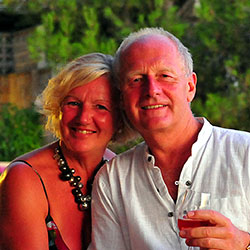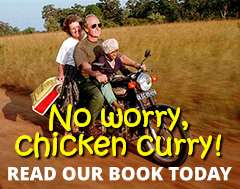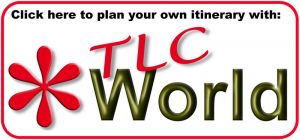Nha Trang in Vietnam is best known as a beach resort for its miles of wide, clean white sand but if you delve a little deeper you’ll find a few treasures and fascinating local life.
Not particularly attracted to lazing on a beach, as our threshold of boredom is fairly low, we elect to travel around Nha Trang to try to get a flavour of local life. We walk into the TTC Michelia Hotel on the junction of Le Loi and Pasteur roads and simply ask to use one of their vehicles.
It’s a bit of a struggle as they seem to speak only Vietnamese, or Russian! Although we pay over the odds compared with a local taxi, for the sake of about £20 (for about 3hrs) we get the use of a smart, clean Mercedes saloon with a well presented driver to take us around in air-conditioned comfort.

Just one of the white sand beaches that Nha Trang is known for
Today, we want to mix it with the locals, see all there is to see in Nha Trang but avoid getting hot, dirty and sticky in the process – which is what normally happens when we buzz around in rickshaws.
Although what we’ll get from our relatively short tour will be little more than a snapshot, we’ll nevertheless cram far more ‘quality time’ at the various venues than we would by navigating our own way around on public transport.
Nah Trang has some quite unusual sights to see, if you can be tempted away from the beach.

The Catholic ‘Stone Church,’ or King Cathedral
Whilst still in the heart of the city we visit the Stone Church, or King Cathedral, at face value quite an austere lump on the ‘Bong’ mountain pedestal but on closer inspection when alongside its towering presence, a pleasant example of French colonial influence in the region and quite attractive architecturally.
Built in 1929 it was created to spread and cement catholic presence and lifestyle within the region.
It’s always open and as well as being used for worship seems to attract photographers for weddings, films and advertising purposes, being one of the more distinctive sites in the city.

Sean Long, ‘Long Sleep,’ Pagoda
By contrast, our next stop is at Sean Long Pagoda – one of the oldest Buddhist temples in Vietnam.

 The ‘Long Sleep’ pagoda was originally built in 1886 on Mount Trai Thuy but after a severe storm destroyed much of it, was relocated to the foot of the mountain where it resides today.
The ‘Long Sleep’ pagoda was originally built in 1886 on Mount Trai Thuy but after a severe storm destroyed much of it, was relocated to the foot of the mountain where it resides today.
It’s beautifully laid out within its own gardens and although it can be crowded you can still find moments of individual peace within its grounds and temple.
We’re surprised to find a solitary worshipper on his knees in a small pagoda to the side, praying undisturbed by the stream of other worshippers, tourists and local people, who only have eyes for the main pagoda.
It’s amazing to us that these moments of tranquility can still be found in places open to the public.

A moment of peace amidst the hustle and bustle
Colourful throughout with a great deal of ornate decoration, the pagoda sits at the foot of a mountain presided over by a plain white, 14-metre high Buddha sitting in a Lotus flower.
You can climb to the Buddha from the Pagoda.

On route to our next stop we pause at the water’s edge to simply enjoy the colourful spectacle of traditional blue fishing boats coming and going, under repair or simply swinging on their moorings at Hon Cao in the Cai River.

Two of the impressive Po Nagar Cham Towers
The landmark Po Nagar Cham Towers, set on a granite hillside 3km north of Nha Trang centre, were the first stone and brick temples made – built in 784AD after the original wooden structures from 2AD were burnt by Javanese invaders.

The Meditation Hall at Po Nagar
Many centuries ago, worshippers entered through the pillared meditation hall, 10 pillars of which remain, before climbing the steep staircase to the towers. Only four of the original eight towers remain but they nonetheless create an impressive complex that remains of important religious significance to Cham, Chinese and Vietnamese Buddhists today.
Although the towers and pillars are the primary significance of this site, there are other little cameos that attract us.
We’re used to seeing tourist brick-a-brac on sale at shrines and other temples but don’t often see them in production. The lady weaving her material, next to a tower, to create bags and purses provides a pleasant and interesting diversion.
A collection of idols for sale and a small water garden also add colour and charm to the area.
The towers with terraced pyramidal rooves and vaulted interiors are magnificent but their dedication to Shiva and Ganesh (Hindu Gods) underlines the blending and fogging of the dividing lines between Hinduism and many other faiths.

After we’ve left the comfortable embrace of our limousine, we wander the streets of Nha Trang itself to get a better feel of local life.
We wander into a huge indoor market – Dam Market.
Whilst its undoubtedly an authentic local Asian market, located within a huge concrete edifice; with everything from tablecloths and tourist trinkets to fresh toads on sale, it’s not for us as we’re not into buying tat that we don’t know what to do with when we get home.
Nevertheless it’s an insight into Asian psyche if you want to get up close and personal with the local population. Barter like mad if you’re tempted to buy.

By this time we’re feeling peckish and decide to sample some of the local cuisine.
Our principal ‘rule of thumb’ with ‘foreign’ food is to always eat where the locals eat, avoid quiet or empty restaurants and constantly sanitise our own hands.
Stick to this and Nha Trang offers some great choices.
We’ve always been quite adventurous with eating out, wherever we’ve travelled in the world. It’s helped, no doubt, by the fact that we seem to have stomachs like Rhinos but that doesn’t mean we don’t get upsets from time to time.
To us, there seems little point in visiting a country unless you embrace all that it has to offer – and food has to be one of the defining aspects of most countries.
On this occasion, we walk into a busy corner restaurant, Tiem Com at 23 Hoàng Văn Thụ, that’s open on two sides to the road and which is packed with local people. We’re warmly welcomed and although we don’t speak one another’s language, we ask the owner – with gestures, pointing and sounds – to bring us a selection of traditional dishes of their choosing.

Adventures with food bring great results
What follows is a superb meal of…well…we recognise the prawns, which are delicious in a garlic and soy sauce but can’t place the species of fish or the vegetable (possibly pak choi, not in the picture) and we think we’ve got something with beansprouts and, of course, the ubiquitous sticky rice – all of it is exceptionally fresh and really tasty.

It’s not until we get the bill (about £10) that we realise we’ve had cauliflower prawns, ‘fried fish,’ fried garlic spinach and sticky rice!
Beaming smiles all-round are testament to our enjoyment of the meal and the owners delight at having chosen well.
As we leave, the owner points to my camera kit and suggests we keep it close if walking the streets.
We’ve not felt threatened or under scrutiny at any time in our wanderings but it’s good to know these things if the locals consider it wise.

Diamond Bay fishing village scene – to explore next time…

Why not ask us to arrange your own tailor-made travel to get closer to the true character of Vietnam, the Orient and the Far East?

 Let us plan your own inspiring journey to Vietnam and the Far East
Let us plan your own inspiring journey to Vietnam and the Far East
Why not download the TLC World guide brochure or give us a call today on 01202 030443, or simply click ‘enquire’ to submit your own personal itinerary request


























